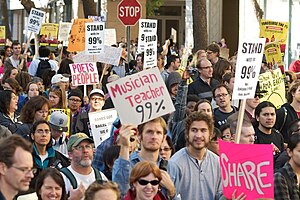| Occupy Oakland | |||
|---|---|---|---|
| Part of the Occupy movement | |||
 Occupy Oakland on November 2, 2011 | |||
| Date | October 10, 2011 | ||
| Location | 37°48′18″N 122°16′18.48″W / 37.80500°N 122.2718000°W | ||
| Caused by |
| ||
| Methods | |||
| Parties | |||
| |||
| Lead figures | |||
| |||
| Arrests and injuries | |||
| Injuries | 4+[1][2] | ||
| Arrested | 400+[citation needed] | ||
Occupy Oakland refers to a collaboration and series of demonstrations in Oakland, California, that started in October 2011. As part of the Occupy movement, protesters have staged occupations, most notably at Frank H. Ogawa Plaza in front of Oakland City Hall.
Occupy Oakland began as a protest encampment at Frank H. Ogawa Plaza on October 10, 2011. Protesters renamed it Oscar Grant Plaza after a young man who was fatally shot by Bay Area Rapid Transit Police in 2009. The encampment was cleared out by multiple law enforcement agencies on October 25, 2011.[3] The movement also helped spur the November 2, 2011, Oakland General Strike that shut down the Port of Oakland. Police again cleared the protest encampment at Frank Ogawa Plaza on November 14, 2011. Other protest encampments were created and subsequently dismantled by law enforcement. The last encampment at Snow Park was cleared on November 21, 2011. Occupy Oakland then had no physical presence in any public space overnight in the city.[4]
Occupy Oakland has often centered on complaints about alleged police misconduct, and relationships between protesters and police were especially frayed at Occupy Oakland.[5] Oakland police estimated that as of April 2012 they had interacted with over 60,000 protesters since the movement began.[6] As of December 2014, Occupy Oakland continued to engage in organized events and actions on a much smaller scale than the earlier demonstrations.[7]
- ^ "Arrests in Oakland protests rise to more than 400 - Yahoo! News". Archived from the original on February 5, 2012. Retrieved January 15, 2017.
- ^ Matthias Gafni; Chris De Benedetti; Rick Hurd (January 29, 2012). "inShare4 Day of clashes at Occupy Oakland ends with at least 400 arrests". Oakland Tribune. Mercury News. Retrieved March 1, 2012.
- ^ Bulwa, Demian (October 25, 2011). "Police clear Occupy Oakland camps, arrest dozens". San Francisco Chronicle. Archived from the original on October 25, 2011. Retrieved October 25, 2011.
- ^ Kane, Will (November 21, 2011). "Police clear out last Occupy Oakland camp". San Francisco Chronicle. Retrieved November 21, 2011.
- ^ Occupy showdown brings whiff of Reagan back to Oakland Archived 2011-11-03 at the Library of Congress Web Archives,
- ^ "Oakland police chief, Alameda County DA defend actions against Occupy Oakland". April 13, 2012.
- ^ "Occupy Oakland: Calendar". Occupyoakland.org (Official website). Retrieved March 3, 2012.